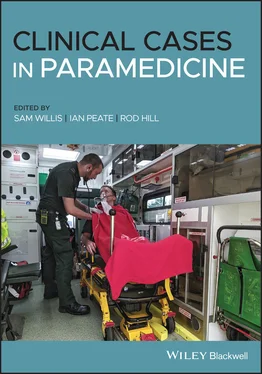Pupils equal and reactive to light (PEARL).
The patient is in his own home.
RR: 36 bpm
HR: 110 bpm
BP: 150/90 mmHg
SpO 2: 86%
Blood glucose: 4.5 mmol/L
Temperature: 37.8 °C
PEF: unable to record
GCS: 15/15
4 Lead ECG: atrial fibrillation
Allergies: nil
Look through the information provided in this case study and highlight all of the information that might concern you as a paramedic.
What is COPD?
COPD is a progressive disease and is characterized by air flow obstruction that is not fully reversible. The airway obstruction results from damage to alveoli, alveolar ducts and bronchioles due to chronic inflammation.
List the features of an acute exacerbation of COPD.
Increased dyspnoea.
Increased sputum production.
Increased cough.
Upper airway symptoms, such as a cold and sore throat.
Increased wheeze.
Reduced exercise tolerance.
Fluid retention.
Increased fatigue.
Acute confusion.
Worsening of previously stable condition.
After administration of 5 mg salbutamol via nebuliser, the patient’s condition improves slightly and he hands you a medical card that his ‘breathing doctor’ gave to him. The card states the patient is at risk of retaining CO 2and should only be administered with 28% oxygen to achieve saturations between 88 and 92%.
Patient assessment triangle
General appearance
Alert and more interactive.
Pink.
Increased work of breathing – breathing rapid, but not as shallow as before.
SYSTEMATIC APPROACH
Danger
None at this time.
Alert.
Clear.
RR: 30. Audible wheeze on auscultation.
HR: 120. Palpable radial. Capillary refill time 2 seconds.
Moving all four limbs.
Normal temperature in the ambulance.
RR: 30 bpm
HR: 120 bpm
BP: 148/78 mmHg
SpO 2: 90%
Blood glucose: not repeated
Temperature: not repeated
GCS: 15/15
4 lead ECG: atrial fibrillation
Allergies: nil
1 When the nebuliser has finished, you notice that the patient’s SpO 2 is dropping so you decide to keep the patient on oxygen. What percentage of oxygen would you administer to this patient and why?28% oxygen through a nasal cannula. The patient is at risk of developing hypercapnia respiratory failure, so it is important the oxygen is titrated to maintain saturations between 88 and 92%. Research suggests that over‐oxygenation increases the mortality and morbidity of COPD patients and that titration of oxygen administration can reduce mortality.
2 What is meant by the term hypercapnia? ‘A condition of abnormally elevated carbon dioxide (CO2) levels in the blood, caused by hypoventilation, lung disease, or diminished consciousness’ (NAEMT, 2015, p. 92).‘Alveolar hypoventilation with increased alveolar carbon dioxide limits the amount of oxygen available for diffusion into the blood, leading to secondary hypoxemia’ (McCance et al., 2010, p. 1269).
LEVEL 2 CASE STUDY
Pulmonary embolism (PE)
| Information type |
Data |
| Time of origin |
17:55 |
| Time of dispatch |
18:01 |
| On‐scene time |
18:10 |
| Day of the week |
Friday |
| Nearest hospital |
30 minutes |
| Nearest backup |
15 minutes |
| Patient details |
Name: Jasmine Wallis DOB: 27/12/2000 |
You have been called to a car park for a 20‐year‐old female who is complaining of feeling dizzy and faint.
She is conscious and breathing.
The car park is behind a row of shops and is poorly lit. The patient is hard to spot at first, as she is sitting on the metal fire escape steps with her head in her hands at the back of a building. She is alone. The car park is full, which prevents you parking near to the patient.
You park your ambulance as near as possible and cross the car park to get to your patient.
On arrival with the patient
The patient is able to raise her head and make eye contact.
Patient assessment triangle
General appearance
The patient looks at you when you speak and is able to speak in full sentences.
Mildly pale.
Increased. The patients looks mildly short of breath.
SYSTEMATIC APPROACH
Danger
None at this time.
Alert.
Clear.
RR: 26. Mildly increased effort, no accessory muscle use. Auscultation – clear.
HR: 120. Tachycardic, weak and regular pulse. Capillary refill time >2 seconds.
Pupils equal and reactive to light (PEARL).
The patient is sitting on metal fire escape stairs, in a dark, cold car park in an undesirable part of town.
RR: 26 bpm
HR: 120 bpm
BP: 90/60 mmHg
SpO 2: 90%
Blood glucose: 4.4 mmol/L
Temperature: 36.5 °C
ECG: sinus tachycardia
Allergies: nil
Look through the information provided in this case study and highlight all of the information that might concern you as a paramedic.
1 List your differential diagnoses for this patient. Musculoskeletal pain.Pericarditis.Hyperventilation.Chest infection.Syncope.Pneumothorax.
2 List as many predisposing factors associated with PE as you can. Which could assist you with working through your differential diagnosis and history taking? See Table 1.2. Table 1.2 Pulmonary embolism predisposing factorsSource: JRCALC (2019), p. 367.Surgery, especially recent Abdominal Pelvic Hip or knee Post‐operative intensive careObstetrics PregnancyCardiac Recent acute myocardial infarctionLimb problems Recent lower limb fractures Varicose veins Lower limb problems secondary to stroke or spinal cord injuryMalignancy Abdominal and /or pelvic, in particular advanced metastatic disease Concurrent chemotherapyOther Risk increases with age >60 years of age Previous proven deep vein thrombosis (DVT)/PE Immobility Thrombotic disorder Neurological disease with extremity paresis Thrombophilia Hormone replacement therapy and oral contraception Prolonged bed rest >3 days Other recent trauma
1 What validated assessment tool could assist you with assessing the probability of PE in this patient? See Table 1.3. Table 1.3 Wells’ criteria for PESource: JRCALC (2019), p. 368.CriteriaScoreClinical signs and symptoms of DVT (leg swelling and pain with palpation of the deep veins)3An alternative diagnosis is PE is less likely3Pulse rate >100 bpm1.5Immobilisation or surgery in the previous 4 weeks1.5Previous DVT/PE1.5Haemoptysis1Malignancy (treatment ongoing or within the last 6 months or palliative)1Clinical probabilityHigh>6 pointsModerate2–6 pointsLow<2 pointsNote: When using the Wells’ criteria, a low probability does not rule out PE.
Читать дальше












